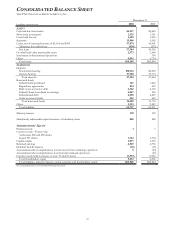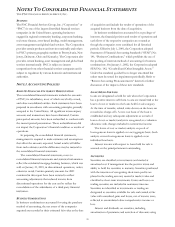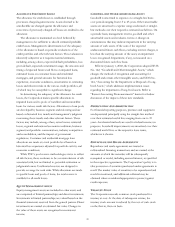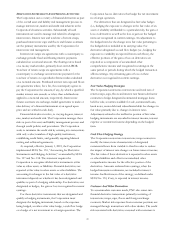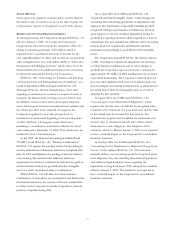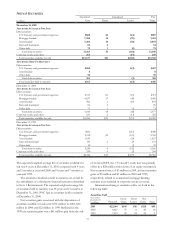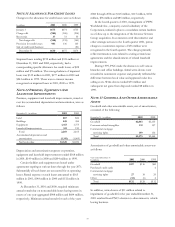PNC Bank 2001 Annual Report Download - page 71
Download and view the complete annual report
Please find page 71 of the 2001 PNC Bank annual report below. You can navigate through the pages in the report by either clicking on the pages listed below, or by using the keyword search tool below to find specific information within the annual report.69
DERIVATIVE INSTRUMENTS AND HEDGING ACTIVITIES
The Corporation uses a variety of financial derivatives as part
of the overall asset and liability risk management process to
manage interest rate, market and credit risk inherent in the
Corporation’s business activities. Substantially all such
instruments are used to manage risk related to changes in
interest rates. Interest rate and total rate of return swaps,
purchased interest rate caps and floors and futures contracts
are the primary instruments used by the Corporation for
interest rate risk management.
Interest rate swaps are agreements with a counterparty to
exchange periodic fixed and floating interest payments
calculated on a notional amount. The floating rate is based
on a money market index, primarily short-term LIBOR.
Total rate of return swaps are agreements with a
counterparty to exchange an interest rate payment for the
total rate of return on a specified reference index calculated
on a notional amount. Purchased interest rate caps and floors
are agreements where, for a fee, the counterparty agrees to
pay the Corporation the amount, if any, by which a specified
market interest rate exceeds or is less than a defined rate
applied to a notional amount, respectively. Interest rate
futures contracts are exchange-traded agreements to make or
take delivery of a financial instrument at an agreed upon
price and are settled in cash daily.
Financial derivatives involve, to varying degrees, interest
rate, market and credit risk. The Corporation manages these
risks as part of its asset and liability management process and
through credit policies and procedures. The Corporation
seeks to minimize the credit risk by entering into transactions
with only a select number of high-quality institutions,
establishing credit limits, and generally requiring bilateral
netting and collateral agreements.
As required, effective January 1, 2001, the Corporation
implemented SFAS No. 133, “Accounting for Derivative
Instruments and Hedging Activities,” as amended by SFAS
No. 137 and No. 138. The statement requires the
Corporation to recognize all derivative instruments at fair
value as either assets or liabilities. Financial derivatives are
reported at fair value in other assets or other liabilities. The
accounting for changes in the fair value of a derivative
instrument depends on whether it has been designated and
qualifies as part of a hedging relationship. For derivatives not
designated as hedges, the gain or loss is recognized in current
earnings.
For those derivative instruments that are designated and
qualify as hedging instruments, the Corporation must
designate the hedging instrument, based on the exposure
being hedged, as either a fair value hedge, a cash flow hedge
or a hedge of a net investment in a foreign operation. The
Corporation has no derivatives that hedge the net investment
in a foreign operation.
For derivatives that are designated as fair value hedges
(i.e., hedging the exposure to changes in the fair value of an
asset or a liability attributable to a particular risk), the gain or
loss on derivatives as well as the loss or gain on the hedged
items are recognized in current earnings. An adjustment to
the hedged item for the change in its fair value pertaining to
the hedged risk is included in its carrying value. For
derivatives designated as cash flow hedges (i.e., hedging the
exposure to variability in expected future cash flows), the
effective portions of the gain or loss on derivatives are
reported as a component of accumulated other
comprehensive income and recognized in earnings in the
same period or periods during which the hedged transaction
affects earnings. Any remaining gain or loss on these
derivatives is recognized in current earnings.
Fair Value Hedging Strategies
The Corporation enters into interest rate and total rate of
return swaps, caps, floors and interest rate futures derivative
contracts to hedge designated commercial mortgage loans
held for sale, securities available for sale, commercial loans,
bank notes, senior debt and subordinated debt for changes in
fair value primarily due to changes in interest rates.
Adjustments related to the ineffective portion of fair value
hedging instruments are recorded in interest income, interest
expense or noninterest income depending on the hedged
item.
Cash Flow Hedging Strategy
The Corporation enters into interest rate swap contracts to
modify the interest rate characteristics of designated
commercial loans from variable to fixed in order to reduce
the impact of interest rate changes on future interest income.
The fair value of these derivatives is reported in other assets
or other liabilities and offset in accumulated other
comprehensive income for the effective portion of the
derivatives. Amounts reclassed into earnings, when the
hedged transaction culminates, are included in interest
income. Ineffectiveness of the strategy, as defined under
SFAS No. 133, if any, is reported in interest income.
Customer And Other Derivatives
To accommodate customer needs, PNC also enters into
financial derivative transactions primarily consisting of
interest rate swaps, caps, floors and foreign exchange
contracts. Market risk exposure from customer positions are
managed through transactions with other dealers. The credit
risk associated with derivatives executed with customers is






